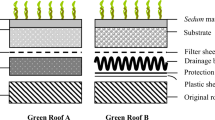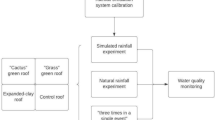Abstract
This paper describes the runoff water quality of Light Weight Aggregates (LWA)-based extensive green roofs and sod roofs in Estonia. Samples were taken from August 2004 to April 2009 from 10 different green roofs to determine what level of water quality may be found. The results presented here show that green roofs influenced water quality to a considerable degree. The runoff water of LWA-based green roofs generally had higher values of pH, BOD7, TP and PO4-P than that from sod roofs. However, COD, TN, SO4 and Ca-Mg salt were higher in the sod roofs than in the green roofs. The results for NH4-N and NO3-N were similar for both roof types. According to the results, the character of the runoff and the contents in the substrate layer at the moment the samples were taken affected runoff quality more than the age and location of the green roof. The use of NPK-nutrients in the substrate or in the soil caused much higher values of COD and concentrations of TP, PO4-P, TN, NH4-N and NO3-N in runoff water than on non-fertilized green roofs. The results of samples taken from the Tartu LWA-based green roof each spring in the period 2005–2009, at a time when the snow had almost melted, showed that concentrations of compounds in runoff water generally decreased gradually. The pH value and Ca-Mg salt concentration were, however, stable, and this was caused by the LWA material.


Similar content being viewed by others
References
Bengtsson L (2005) Peak flows from thin sedum-moss roof. Nordic Hydrol 36(3):269–280
Bengtsson L, Grahn L, Olsson J (2005) Hydrological function of a thin extensive green roof in Southern Sweden. Nordic Hydrol 36(3):259–268
Berndtsson JC (2010) Green roof performance towards management of runoff water quantity and quality: a review. Ecol Eng 36:351–360
Berndtsson JC, Emilsson T, Bengtsson L (2006) The influence of extensive vegetated roofs on runoff water quality. Sci Total Environ 355(1–3):48–63
Berndtsson JC, Bengtsson L, Jinno K (2009) Runoff water quality from intensive and extensive vegetated roofs. Ecol Eng 35:369–380
Carter T, Fowler L (2008) Establishing green roof infrastructure through environmental policy instruments. Environ Manag 42(1):151–164
Del Barrio EP (1998) Analysis of the green roofs cooling potential in buildings. Energy Build 27:179–193
Eumorfopoulou E, Aravantinos D (1998) The contribution of a planted roof to the thermal protection of buildings in Greece. Energy Build 27:29–36
Getter KL, Rowe DB, Andresen JA (2007) Quantifying the effect of slope on extensive green roof stormwater retention. Ecol Eng 31:225–231
Hathaway AM, Hunt WF, Jennings GD (2008) A field study of green roof hydrologic and water quality performance. Trans ASAE 51(1):37–44
Köhler M, Schmidt M (2003) Study of extensive green roofs in Berlin. http://www.roofmeadow.com/technical/publications/SWQuality_Berlin_MSchmidt.pdf
Kotti ME, Vlessidis AG, Thanasoulias NC, Evmiridis NP (2005) Assessment of river water quality in Northwestern Greece. Water Resour Manag 19(1):77–94
Liu K (2003) Engineering performance of rooftop gardens through field evaluation. RCI 18th International Convention and Trade Show, Tampa, Florida, 13–18 March. pp. 1–15
Lloyd SD, Wong THF, Porter B (2002) The planning and construction of an urban stormwater management scheme. Water Sci Technol 45(7):1–10
Mentens J, Raes D, Hermy M (2006) Green roofs as a tool for solving the rainwater runoff problem in the urbanized 21st century? Landsc Urban Plan 77(3):217–226
Moran A, Hunt B, Smith J (2005) Hydrologic and water quality performance from greenroofs in Goldsboro and Raleigh, North Carolina. In: Proceedings of the third North American green roof conference: greening rooftops for sustainable communities. The Cardinal Group, Washington, DC.
National program for environmental monitoring: meteorological monitoring, air monitoring (2009) (in Estonian) http://eelis.ic.envir.ee:88/seireveeb/index.php?id=13
Park MH, Stenstrom M, Pincetl S (2009) Water quality improvement policies: lessons learned from the implementation of proposition O in Los Angeles, California. Environ Manag 43(3):514–522
Quality indicators of drinking water in Tartu (2009) (in Estonian) http://www.tartuvesi.ee/?mm=9100124
Rules of effluent channelling into bodies of water or soil (2001) RT I, 69, 424 (in Estonian) https://www.riigiteataja.ee/ert/act.jsp?id=998336
Scholz M (2004) Case study: design, operation, maintenance and water quality management of sustainable storm water ponds for roof runoff. Bioresour Technol 95(3):269–279
Takebayashi H, Moriyama M (2007) Surface heat budget on green roof and high reflection roof for mitigation of urban heat island. Build Environ 42:2971–2979
Teemusk A, Mander Ü (2007) Rainwater runoff quantity and quality performance from a greenroof: the effects of short-term events. Ecol Eng 30:271–277
Teemusk A, Mander Ü (2009) Greenroof potential to reduce temperature fluctuations of a roof membrane: a case study from Estonia. Build Environ 44:643–650
Theodosiou TG (2003) Summer period analysis of the performance of a planted roof as a passive cooling technique. Energy Build 35:909–917
Villarreal EL (2007) Runoff detention of a sedum green-roof. Nordic Hydrol 38:99–105
Water quality of Lake Ülemiste (2009) (in Estonian) http://www.tallinnavesi.ee/static/files/411.ylemiste%20vee%20kvaliteet%2001.2008.pdf
Wong NH, Cheong DKW, Yan H, Soh J, Ong CL, Sia A (2003a) The effects of rooftop gardens on energy consumption of a commercial building in Singapore. Energy Build 35:353–364
Wong NH, Chen Y, Ong CL, Sia A (2003b) Investigation of thermal benefits of rooftop garden in the tropical environment. Build Environ 38:261–270
Wong NH, Yok TP, Yu C (2007) Study of thermal performance of extensive rooftop greenery systems in the tropical climate. Build Environ 42:25–54
Acknowledgements
This study was supported by Estonian Science Foundation grant No. 7527 and Target Funding Project No. SF0180127s08 of the Ministry of Education and Science of Estonia.
Author information
Authors and Affiliations
Corresponding author
Rights and permissions
About this article
Cite this article
Teemusk, A., Mander, Ü. The Influence of Green Roofs on Runoff Water Quality: A Case Study from Estonia. Water Resour Manage 25, 3699–3713 (2011). https://doi.org/10.1007/s11269-011-9877-z
Received:
Accepted:
Published:
Issue Date:
DOI: https://doi.org/10.1007/s11269-011-9877-z




